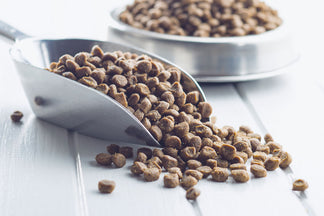Many dogs and believe it or not, even some cats have a tendency to devour their food when presented with their meal. Labrador Retrievers are one canine breed that is infamous for their appetites. As a long time Lab owner, I can vouch for the fact that these dogs can literally inhale their food.
Pets that eat rapidly are more likely to present with an assortment of ailments related to their speed eating including:
- Choking
- Vomiting
- Gastrointestinal discomfort
- Food bloat, which can occur from gulping food and swallowed air and is potentially life threatening
Like humans, pets who gulp their food might also not feel their satiety and thus, have an increased desire for more food, at least in the short term. This could lead to increased begging or those sad faces that make you want to give them more food or treats.
Slow feed bowls are designed to prevent gulping. They typically have ridges or other barriers that break up the bowl’s surface area, which prevents the pet from being able to inhale their food in one or two gulps. These types of bowls can help reduce the likelihood that your pet will gulp down their meals and thus, they are meant to alleviate the issues associated with fast eating.
However, these bowls can also potentially cause some health and other problems related to their construction.
- Chipped teeth. Pets can chip their teeth from biting around the barriers
- Ingested plastic or other non-edible materials that are used to construct the bowl. This can lead to gastrointestinal distress among other things.
- Food mess. If the bowl is not adequately sturdy, some pets could end up flipping the bowl as they work to get their food. This could defeat the purpose of the bowl plus leave a residual food mess for the owner to clean up.
- Bowl mess. Some of the slow feed bowls can also be harder to clean properly than regular bowls.
Next: How the SmartFeeder can help with food gulping.

 Food
Food
 Food
Food
 Food
Food
